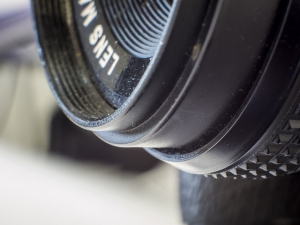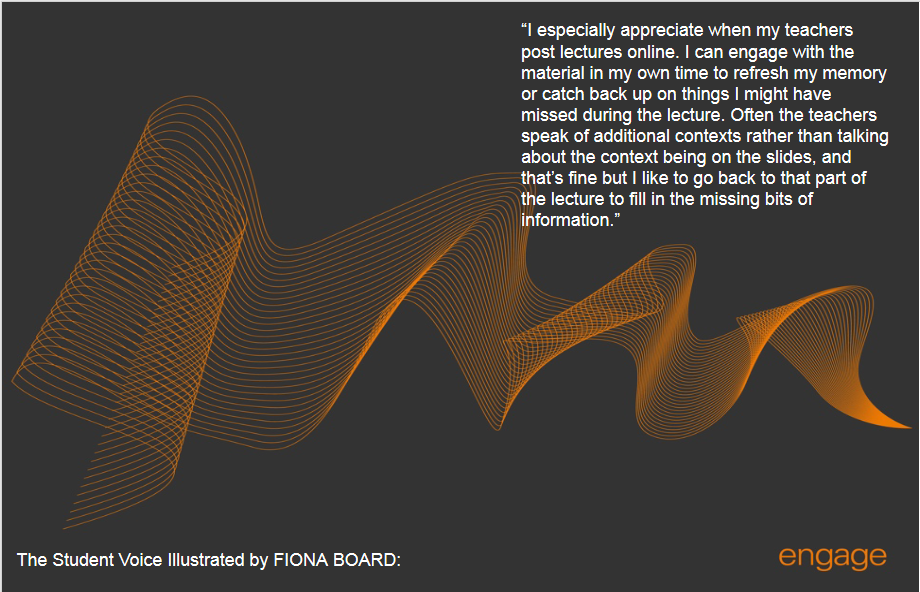Impact and student use of lecture recording
 Lecture recording is becoming more established in Higher Education with 71% of institutions reporting using it in 2016 (UCISA, 2016) and many moving towards an opt out system.
Lecture recording is becoming more established in Higher Education with 71% of institutions reporting using it in 2016 (UCISA, 2016) and many moving towards an opt out system.
At LSE an increasing number of courses are using lecture recording to support students. In 2016/17, 6445 lectures were recorded (a 12.7% rise in recordings from 2015/6) and with over 5000 recordings already completed this academic year we are on track to record an additional 25% more content for 2017/18.
Despite the expansion in the use of lecture recording there is still a concern amongst some academic staff that recording lectures will lead to a decrease in lecture attendance. These Academics should be relieved to hear about the results of a recent study at the University of Aberdeen by Emily Nordmann, Colin Calder, Paul Bishop, Amy Irwin and Darren Comber, published in January 2018 the team found “no evidence for a negative effect of recording use, or that attendance and recording use were related”. The study spanned four years of an Undergraduate programme in order to review the impact of attendance, lecture recording and student attainment. They concluded that lecture recordings were the most beneficial for first year undergraduates, particularly non native speakers. Weaker students gained from supplementary use of recordings but only the stronger students were able to use the recordings to overcome the impact of low attendance. These differences were not present in the second year onwards as “attendance and recording use were positively correlated with, but no longer predictive of, achievement”.
Students’ use of lecture capture
 These findings have been reinforced by recent analysis of LSE lecture recording statistics and interviews and surveys with LSE students for five core first year undergraduate courses.
These findings have been reinforced by recent analysis of LSE lecture recording statistics and interviews and surveys with LSE students for five core first year undergraduate courses.
The study carried out by student research assistants for LTI found that:
- the majority of students watch the whole lecture once and then repeat and re-watch at points of difficulty with the number of views for this purpose being significantly higher for quantitative subjects
- Very few students used lecture recordings as a replacement for attendance, preferring to use it as a revision tool or where they had valid reasons to miss the lecture (such as a clash). This complementary role for lecture recording came through very strongly in the quantitative data;
“This [lecture recording] is still far more useful than merely having the lecture to depend on – I’ve literally watched certain parts of a lecture 6-8 times just to make sure I absolutely understand the content of the lecture. I usually watch each lecture at least twice as well”.
(Comment from EC102 student, EC102, is the most watched course in the School, with students watching each lecture on average seven times over the academic year. The most watched lecture was Week 11 of EC210 which was watched just over 5000 times.)
This us e of lecture recordings to supplement lecture attendance is not restricted to the Social Sciences. In 2013 Peter Reed conducted a survey on lecture recording with 840 students at the Faculty of Health and Life Sciences at the University of Liverpool. He found 92% of respondents wanted to be able to access recordings to clarify aspects they didn’t understand in class, and 87% would use them to prepare for summative assessment. Accessing recordings instead of going to lectures was of interest to only a small proportion of students (7%).
e of lecture recordings to supplement lecture attendance is not restricted to the Social Sciences. In 2013 Peter Reed conducted a survey on lecture recording with 840 students at the Faculty of Health and Life Sciences at the University of Liverpool. He found 92% of respondents wanted to be able to access recordings to clarify aspects they didn’t understand in class, and 87% would use them to prepare for summative assessment. Accessing recordings instead of going to lectures was of interest to only a small proportion of students (7%).
Additionaly an LTI literature review in 2013 illustrated that students in most studies preferred access to live lectures, with most preferring a blended format incorporating lecture recordings, live lectures, course materials and additional classes.
Lecture recording at LSE
 At LSE the Echo360 lecture recording system is currently installed in 43 rooms. Teachers that are timetabled to lecture in a room with recording devices installed are able to schedule lecture recording on LSEForYou, if the teacher opts in the recordings are automatically recorded and can be made available to students on Moodle using the Echo360 Activity.
At LSE the Echo360 lecture recording system is currently installed in 43 rooms. Teachers that are timetabled to lecture in a room with recording devices installed are able to schedule lecture recording on LSEForYou, if the teacher opts in the recordings are automatically recorded and can be made available to students on Moodle using the Echo360 Activity.
The recording displays the audio and video of the screen/visualiser in classrooms and the projector and presenter in larger lecture theatres. See the LTI website for a list of room with lecture capture devices.
Next steps for lecture recording at LSE
LTI are working with AV and IMT to improve the quality of lecture recordings and are currently working on creating various resources to help lecturers to use lecture recording facilities.
IMT AV recently upgraded the hardware in Clements House lecture rooms in order to improve audio and video quality. There are further development plans for lecture recording capable rooms starting with 32LIF which is due for an upgrade over the easter break. Longer term the new LSE buildings should increase the capacity for lecture recording.
LTI are also working with various teams around the school such as timetables and LFY to solve the inability to automatically schedule seminars that are taught in a lecture style. We are hopeful to have this resolved for the next Michaelmas term.
Alongside making constant improvements to the system we are also looking to innovate lecture recording and encourage lecturers to think about how they could use recordings in different ways inclusing using personal capture to produce online resources to support face to face activities. Part two of this post will look at how technology can be used to rethink your lectures and make them more engaging and interactive.
If you are interested in using lecture recording see our website for guides and FAQ’s and if you have any queries please email: IMT.Lecturerecording@lse.ac.uk
References
Bond, Steve and Grussendorf, Sonja (2013), Staff Attitudes to Lecture Capture. The London School of Economics and Political Science, London, UK.
Grummett, D and Appleby-Donald, E (2016, June 1) ‘Does lecture capture enhance learning?’


 Jane and I participated in a one day in-house symposium at the University of York this week. The audience were made up of both academic and support staff interested in learning from other universities about lecture capture, audio and video content production and Second Life. We were asked to talk about audio and video content production and so showcased some of the video & audio that’s produced here. We focused on lecture capture momentarily as although it is the most prolific output of media at the LSE, with 909 lectures having been captured in just one term this year, two other universities: Birmingham and Newcastle had already given extensive presentations on this subject. Instead, we wanted to highlight the idea of audio and video as a part of teaching, not just as a means to capture the teaching that’s already going on. We played examples of interviews & discussions, role playing scenes, groupwork, screencasts, video and audio podcasts as well as highlighting some of the Wimba tools and audio feedback. We also talked about the issue of scaling up to meet increased interest in media, professionally produced video vs the DIY approach and touched on the copyright issues involved.
Jane and I participated in a one day in-house symposium at the University of York this week. The audience were made up of both academic and support staff interested in learning from other universities about lecture capture, audio and video content production and Second Life. We were asked to talk about audio and video content production and so showcased some of the video & audio that’s produced here. We focused on lecture capture momentarily as although it is the most prolific output of media at the LSE, with 909 lectures having been captured in just one term this year, two other universities: Birmingham and Newcastle had already given extensive presentations on this subject. Instead, we wanted to highlight the idea of audio and video as a part of teaching, not just as a means to capture the teaching that’s already going on. We played examples of interviews & discussions, role playing scenes, groupwork, screencasts, video and audio podcasts as well as highlighting some of the Wimba tools and audio feedback. We also talked about the issue of scaling up to meet increased interest in media, professionally produced video vs the DIY approach and touched on the copyright issues involved. This week I’m attending the 9th annual
This week I’m attending the 9th annual  Here at LSE we’ve been using lecture capture systems for a few years now, starting with Anystream Apreso and moving on to EchoSystem by Echo 360 over the last academic year. I’ve been meaning to post a review of our experience of implementing these systems on this blog, never quite getting around to it. Eventually, the editor of the Association for Learning Technology newsletter asked Chris Fryer and myself to write a review, which you can find in full on the
Here at LSE we’ve been using lecture capture systems for a few years now, starting with Anystream Apreso and moving on to EchoSystem by Echo 360 over the last academic year. I’ve been meaning to post a review of our experience of implementing these systems on this blog, never quite getting around to it. Eventually, the editor of the Association for Learning Technology newsletter asked Chris Fryer and myself to write a review, which you can find in full on the 




